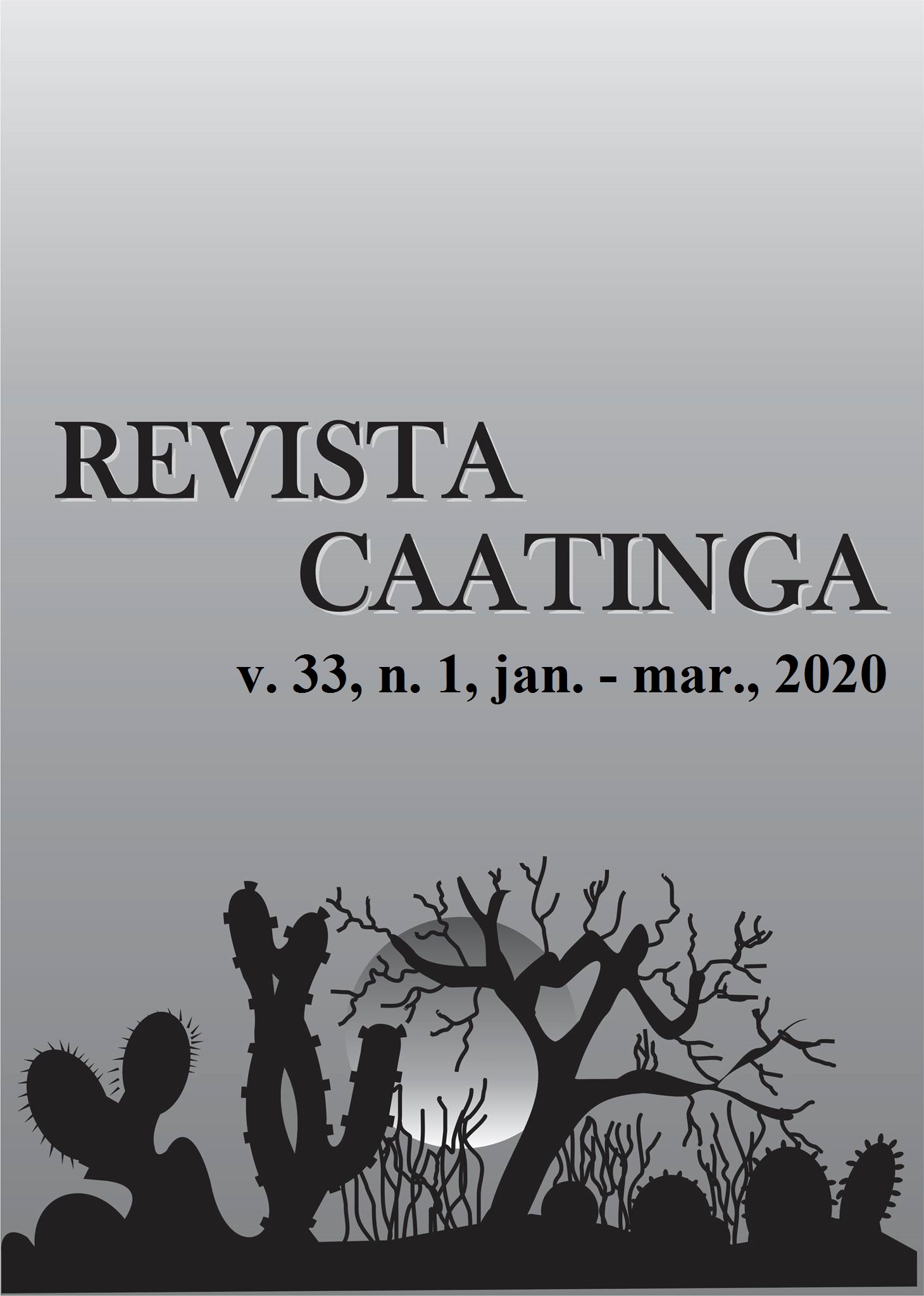SOURCES AND CONCENTRATIONS OF CUPRIC FUNGICIDES FOR THE CONTROL OF CITRUS BLACK SPOT
DOI:
https://doi.org/10.1590/1983-21252020v33n101rcKeywords:
Citrus sinensis. Phyllosticta citricarpa. Cobre metálico.Abstract
Citrus black spot (CBS) is a severe disease for citriculture in the São Paulo State, Brazil. Part of its management is focused on chemical control using cupric fungicides and strobilurins. The objective of the present work was to evaluate the efficacy of three sources and three concentrations of cupric fungicides (copper hydroxide, copper oxychloride and cuprous oxide). Orange fruits of the Pera cultivar were bagged in the plants and the treatment with cupric fungicide was applied. The fruits were inoculated (by spray) with Phyllosticta citricarpa (1×104 conidia mL-1) after 0, 7, 14, 21, and 28 days, and bagged again. The evaluation of incidence and severity was did at the harvest time of fruits. A second experiment was conducted under natural infection with the same treatments, consisting of application of fungicides at the stages F1 (petal fall) and F2 (fruits with diameter of 1 cm), using mechanized sprayer with mean flow of 7.35 L solution plant-1. Subsequently, all treatments received four applications of azoxystrobin (30 g ha-1), plus mineral oil at 0.25%. Four monthly evaluations were done to determine the CBS incidence and severity. The initial applications with cupric fungicides are essential for the control of CBS; the fungicide copper hydroxide showed the best control of CBS with the lowest rate of metallic copper (43.7 g of Cu++ 100 L-1) in both experiments, regardless of the conduction conditions.
Downloads
References
AGUIAR, R. L. et al. Período de incubação de Guignardia citricarpa em diferentes estádios fenológicos de frutos de laranjeira ‘Valência’. Tropical Plant Pathology, 37: 155-158, 2012.
ALMEIDA, T. F.; REIS, R. F.; GOES, A. Method of inoculation of Guignardia citricarpa (Phyllosticta citricarpa) on ‘Pêra Rio’ sweet orange fruit. In: IX INTERNATIONAL CONGRESS OF PLANT PATHOLOGY, 2008, Torino. Proceedings... 2008. International Society for Plant Pathology, 2008. 1: 158-159.
BALDASSARI, R. B.; WICKERT, E.; GOES, A. Pathogenicity, colony morphology and diversity of isolates of Guignardia citricarpa and G. mangiferae isolated from Citrus spp. Europe Journal Plant Pathology, 120: 103-110, 2008.
BRASIL. Ministério da Agricultura, pecuária e Abastecimento - MAPA. AGROFIT - Sistema de Agrotóxicos Fitossanitários. Disponível em: <http://agrofit.agricultura.gov.br/agrofit_cons/principal_agrofit_cons>. Acesso em: 24 mai. 2017.
European and Mediterranean Plant Protection Organization - EPPO. PQR-EPPO data base on quarantine pests. 2017. Disponível em: <http://www.eppo.int/DATABASES/pqr/pqr.htm>. Acesso em: 30 ago. 2017.
FEICHTENBERGER, E. et al. Competição de fungicidas à base de cobre no controle da mancha preta (Guignardia citricarpa) em laranjeiras 'Folha Murcha'. Fitopatologia Brasileira, 26: 444-449, 2001.
HIDALGO G.; PÉREZ V. L. Diferenciación morfológica, cultural y biológica de Guignardia citricarpa y Guignardia mangiferae en frutos cítricos de Cuba. Fitosanidad, 14: 141–152, 2010.
IKEDA, M. Efeito de fungicidas do grupo químico das estrobilurinas no controle da mancha preta dos citros, na produção e na qualidade tecnológica dos frutos. 2011. 35 f. Dissertação (Mestrado em Agronomia: Área de Concentração em Produção Vegetal) - Faculdade de Ciências Agrárias e Veterinárias, Unesp, Jaboticabal, 2011.
KOTZÉ, J. M. Citrus black spot. In: TIMMER, L.W.; GARNSEY, S. M.; GRAHAM, J. H. (Eds.). Compendium of Citrus Diseases. St. Paul, MN: The American Phytopathological Society, 2000. v. 2, cap. 6, p. 595-634.
MOTTA, R. R. Determinação do período residual de fungicidas protetor e sistêmico para o controle de Guignardia citricarpa em frutos cítricos. 2009. 84 f. Dissertação (Mestrado em Agronomia: Área de Concentração em Produção Vegetal) – Faculdade de Ciências Agrárias e Veterinárias, Unesp, Jaboticabal, 2009.
SCALOPPI, E. M. T. et al. Efeito do manejo cultural e químico na incidência e severidade da mancha-preta dos citros. Revista Brasileira de Fruticultura, 34: 102-108, 2012.
SCHUBERT, T. et al. Citrus Black Spot (Guignardia citricarpa) Discovered in Florida. 2010. Disponível em: . Acesso em: 22 mai. 2017.
SILVA JUNIOR, G. J. et al. Pinta preta: a doença e seu manejo. Araraquara, SP: Fundecitrus, 2016. 208 p.
SPÓSITO, M. B. et al. Elaboração e validação de escala diagramática para avaliação da severidade da mancha preta em frutos cítricos. Fitopatologia Brasileira, 29: 81-85, 2004.
STOLLER DO BRASIL LTDA. Guia de fases de desenvolvimento: Citros. 1. ed. Cosmópolis, SP, 2010. 4 p.
TIMMER, L. W.; GARNSEY, S. M.; GRAHAM, J. H. Compendium of Citrus Diseases. 2. ed. Lake Alfred, FL: IFLA, 2000, 92 p.
VINHAS, T. Controle químico da Guignardia citricarpa, agente causal da mancha preta dos citros em frutos de laranja ‘Valência’. 2011. 41 f. Dissertação (Mestrado em Agronomia: Área de Concentração em Master Citrus) - Fundo de Defesa da Citricultura, Araraquara, 2011.
WHEELER, B. E. J. An introduction to plant disease. London: John Wiley & Sons, 1969. 374 p.
Downloads
Published
Issue
Section
License
Os Autores que publicam na Revista Caatinga concordam com os seguintes termos:
a) Os Autores mantêm os direitos autorais e concedem à revista o direito de primeira publicação, com o trabalho simultaneamente licenciado sob a Licença Creative Commons do tipo atribuição CC-BY, para todo o conteúdo do periódico, exceto onde estiver identificado, que permite o compartilhamento do trabalho com reconhecimento da autoria e publicação inicial nesta revista, sem fins comerciais.
b) Os Autores têm autorização para distribuição não-exclusiva da versão do trabalho publicada nesta revista (ex.: publicar em repositório institucional ou como capítulo de livro), com reconhecimento de autoria e publicação inicial nesta revista.
c) Os Autores têm permissão e são estimulados a publicar e distribuir seu trabalho online (ex.: em repositórios institucionais ou na sua página pessoal) a qualquer ponto antes ou durante o processo editorial, já que isso pode gerar alterações produtivas, bem como aumentar o impacto e a citação do trabalho publicado (Veja O Efeito do Acesso Livre).







